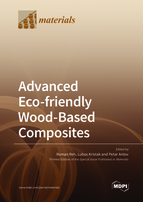Advanced Eco-friendly Wood-Based Composites
A special issue of Materials (ISSN 1996-1944). This special issue belongs to the section "Advanced Composites".
Deadline for manuscript submissions: closed (20 May 2022) | Viewed by 38069
Special Issue Editors
Interests: wood-based composites; wood adhesives; wood sciences; wood physics
Special Issues, Collections and Topics in MDPI journals
Interests: physics; materials; thermal properties; wood sciences; wood physics
Special Issues, Collections and Topics in MDPI journals
Interests: wood and wood-based composites; eco-friendly wood-based composites; lignocellulosic composites; wood technology; wood sciences; bio-based adhesives; advanced formaldehyde-based wood adhesives; formaldehyde emission; formaldehyde scavengers; recyclable materials; sustainability; bioeconomy
Special Issues, Collections and Topics in MDPI journals
Special Issue Information
Dear Colleagues,
Traditional wood-based composites are produced with synthetic, formaldehyde-based wood adhesives, commonly made from petroleum-derived constituents, such as urea, phenol, melamine, etc. Along with their numerous advantages, these adhesives are characterized by certain problems, connected with the emission of hazardous volatile organic compounds (VOCs), including free formaldehyde emission from the finished wood-based composites, which is related to a number of serious environmental problems and adverse human-health effects, such as skin and eye irritation, respiratory problems, and cancer. The transition to circular, low-carbon bioeconomy, the growing environmental concerns and the strict legislation related to the emission of harmful VOCs, e.g. free formaldehyde, from wood-based composites, have posed new requirements related to the development of sustainable, eco-friendly wood-based composites, optimization of the available lignocellulosic resources, and use of alternative raw materials. The harmful formaldehyde release from wood-based composites can be reduced by adding various inorganic, organic, and mineral compounds as formaldehyde scavengers to conventional adhesive systems, such as phosphates, salts, urea, nanoparticles, bark, lignin, tannins, etc., by surface treatment of finished wood-based panels, or by using eco-friendly, formaldehyde-free wood adhesive formulations.
This Special Issue, “Advanced Eco-friendly Wood-Based Composites” is focused on high-quality original research and review articles on topics including but not limited to the latest approaches in the development of novel environmentally friendly wood-based composites; sustainable, bio-based wood adhesives; approaches to reduce formaldehyde emission from wood-based composites; binderless wood-based panels; wood plastic composites (WPC); natural matrix/non-wood natural fiber composites; innovative approaches and processes for recycling wood-based composites; thermal and chemical technologies for enhanced protection of wood and wood-based composites; application of nanomaterials to wood-based composites; valorisation of bark for value-added chemicals and production of wood composites; non-wood lignocellulosic composites; advanced functionalities and application of wood-based panels.
We strongly encourage contributions from wood scientists and experts from all related fields in the form of original research works or review articles.
With kind regards,
Prof. Dr. Roman Reh
Dr. Lubos Kristak
Dr. Petar Antov
Guest Editors
Manuscript Submission Information
Manuscripts should be submitted online at www.mdpi.com by registering and logging in to this website. Once you are registered, click here to go to the submission form. Manuscripts can be submitted until the deadline. All submissions that pass pre-check are peer-reviewed. Accepted papers will be published continuously in the journal (as soon as accepted) and will be listed together on the special issue website. Research articles, review articles as well as short communications are invited. For planned papers, a title and short abstract (about 100 words) can be sent to the Editorial Office for announcement on this website.
Submitted manuscripts should not have been published previously, nor be under consideration for publication elsewhere (except conference proceedings papers). All manuscripts are thoroughly refereed through a single-blind peer-review process. A guide for authors and other relevant information for submission of manuscripts is available on the Instructions for Authors page. Materials is an international peer-reviewed open access semimonthly journal published by MDPI.
Please visit the Instructions for Authors page before submitting a manuscript. The Article Processing Charge (APC) for publication in this open access journal is 2600 CHF (Swiss Francs). Submitted papers should be well formatted and use good English. Authors may use MDPI's English editing service prior to publication or during author revisions.
Keywords
- eco-friendly wood-based panels
- bio-based wood adhesives
- advanced formaldehyde-based wood adhesives
- formaldehyde scavengers
- biopolymer composites
- lignocellulosic composites
- reinforced composite structures
- wood plastic composites
- wood modification
- nanotechnology and nanomaterials
- mechanical properties








